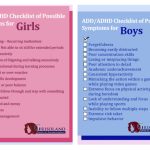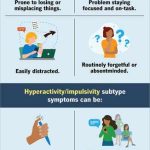Add/ADHD in Girls vs Add/ADHD in Boys: The Hidden Truth
When it comes to Attention Deficit Hyperactivity Disorder (ADD/ADHD), many of us tend to think of boys as the primary sufferers. After all, the stereotypical image of a hyperactive kid is often associated with boys, right? But what about girls? What if we told you that ADD/ADHD in girls can be just as prevalent and debilitating as it is in boys – but for entirely different reasons?
Breaking Down the Barriers: Why It Matters
The truth is, ADD/ADHD in girls often goes undiagnosed or misdiagnosed because of societal expectations. We tend to view girls as more empathetic and organized than boys, which can mask their symptoms and make it harder for them (and their parents) to recognize the signs. But the impact of untreated ADD/ADHD on girls’ lives is just as severe: missed opportunities, low self-esteem, and even mental health issues.
A Closer Look at the Numbers
According to the Centers for Disease Control and Prevention (CDC), roughly 11% of children with ADD/ADHD are girls. While this might not seem like a significant difference from boys, consider that most studies on ADD/ADHD focus solely on boys – leaving girls’ symptoms and experiences largely unexplored. By shining a light on the unique challenges faced by girls with ADD/ADHD, we can finally give them the attention and support they deserve.
The Hidden Symptoms: Why Girls’ ADD/ADHD is Often Overlooked
When we think of girls with ADD/ADHD, we often imagine them as quiet and reserved, but actually, their symptoms can be just as varied and intense as those exhibited by boys. The key difference lies in how these symptoms manifest. Girls are more likely to internalize their feelings, leading to anxiety, depression, or even eating disorders rather than exhibiting hyperactive behavior.
For instance, a girl with ADD/ADHD might struggle to stay focused during schoolwork, leading her to feel overwhelmed and frustrated. She might also have trouble organizing her tasks, assignments, and time management, resulting in missed deadlines or forgotten appointments. These symptoms can be misinterpreted as simply being “clumsy” or “spacey,” rather than recognizing them as signs of ADD/ADHD.
The Power of Social Expectations
Social expectations play a significant role in how we perceive and diagnose ADD/ADHD in girls. We often assume that boys are naturally more energetic and impulsive, making it easier to recognize their symptoms as ADD/ADHD. However, when girls exhibit similar behaviors, they’re often dismissed as “tomboys” or simply told to “calm down.”
According to the National Institute of Mental Health (NIMH), girls with ADD/ADHD are more likely to experience comorbid conditions such as depression, anxiety, and eating disorders. These co-occurring conditions can make it even more challenging for girls to receive an accurate diagnosis and effective treatment.
The Importance of Awareness
Raising awareness about ADD/ADHD in girls is crucial for providing them with the necessary support and resources. By acknowledging the unique challenges they face, we can work towards creating a more inclusive environment that recognizes their struggles and provides appropriate accommodations.
As we continue to learn more about ADD/ADHD in girls, it’s essential to keep in mind that every individual is unique, and symptoms can vary widely. By staying informed and open-minded, we can help create a world where girls with ADD/ADHD feel empowered to seek the help they need and thrive despite their challenges.
Learn more about ADD/ADHD from the Centers for Disease Control and Prevention (CDC)Get Expert Advice on ADD/ADHD in Girls and Boys
Don’t hesitate to reach out for guidance and support.
Consult with a Medical & Health ExpertAdd/ADHD in Girls vs Add/ADHD in Boys: The Hidden Truth
When it comes to Attention Deficit Hyperactivity Disorder (ADD/ADHD), many of us tend to think of boys as the primary sufferers. After all, the stereotypical image of a hyperactive kid is often associated with boys, right? But what about girls? What if we told you that ADD/ADHD in girls can be just as prevalent and debilitating as it is in boys – but for entirely different reasons?
Breaking Down the Barriers: Why It Matters
The truth is, ADD/ADHD in girls often goes undiagnosed or misdiagnosed because of societal expectations. We tend to view girls as more empathetic and organized than boys, which can mask their symptoms and make it harder for them (and their parents) to recognize the signs. But the impact of untreated ADD/ADHD on girls’ lives is just as severe: missed opportunities, low self-esteem, and even mental health issues.
A Closer Look at the Numbers
According to the Centers for Disease Control and Prevention (CDC), roughly 11% of children with ADD/ADHD are girls. While this might not seem like a significant difference from boys, consider that most studies on ADD/ADHD focus solely on boys – leaving girls’ symptoms and experiences largely unexplored. By shining a light on the unique challenges faced by girls with ADD/ADHD, we can finally give them the attention and support they deserve.
What’s Next?
In our next installment, we’ll be exploring the specific symptoms of ADD/ADHD in girls – from daydreaming to restlessness. We’ll also dive deeper into the ways that societal expectations and gender norms can influence how girls experience and express their ADHD. Stay tuned for a more nuanced understanding of this often-overlooked topic.
Join the Conversation!
We want to hear from you! Share your thoughts on ADD/ADHD in girls and boys, and let’s work together to create a more inclusive and supportive environment for all. Join our community today and stay up-to-date on the latest developments in this important area of research.
Uncover the Mysterious World of Skin Hunks Holes: Are you curious about those pesky bumps on your skin? This intriguing article takes a deep dive into the world of skin hunks holes, revealing surprising facts and insights that will leave you wanting more.
Mysterious Rash on Back and Chest? Get Answers Here: Are you dealing with a stubborn rash on your back or chest that won’t go away? This informative article provides expert advice and guidance to help you identify the cause and find effective solutions for relief.




